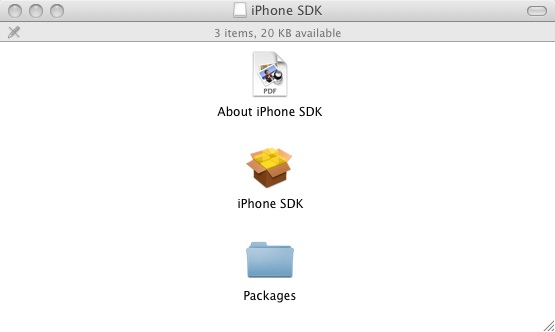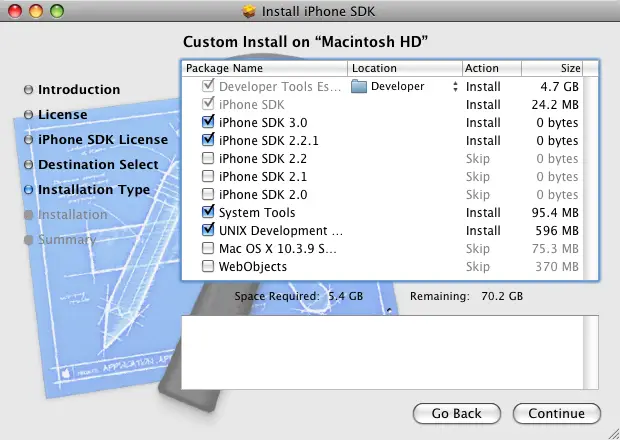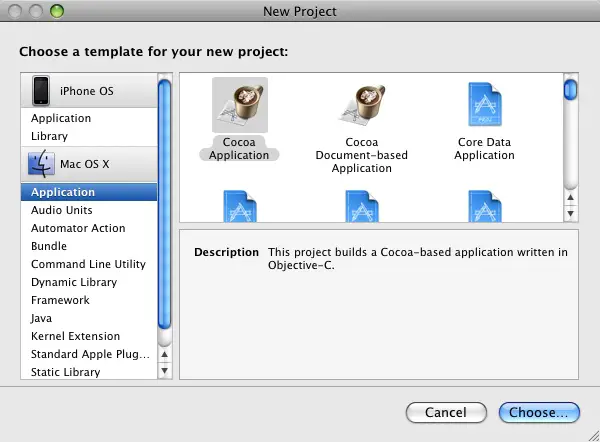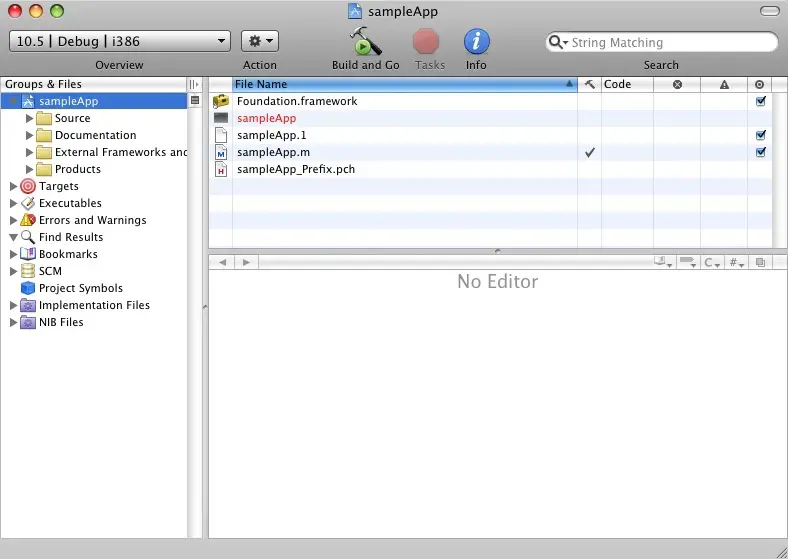In later chapters we will look at how to install and use Objective-C on Windows and Linux systems for those that do not have access to Mac OS X. If you are planning to develop iPhone applications (or Mac OS X applications for that matter), however, you are
going to need to use an Intel based Mac OS X system at some point in the future.
Perhaps the biggest advantage of using Mac OS X as your Objective-C learning platform (aside from the ability to develop iPhone and Mac OS X applications) is the fact that you get to use Apple's Xcode development tool. Xcode is a powerful and easy to use
development environment that is available free of charge to anyone fortunate enough to own an Apple computer running Mac OS X.
In this chapter we will cover the steps involved in installing Xcode and writing and compiling a simple Objective-C program in this environment. For those readers that prefer to do their coding and compiling at the command prompt we will then cover use of
Objective-C in a terminal window.
Installing Xcode on Mac OS X
Xcode may or may not be pre-installed on your Mac OS X system. To find out if you already have it, open the Finder and look for it in theDeveloper subfolder of the
Applications folder. If the Developer folder does not exist, or does not contain Xcode then you will need to install it.
The best way to obtain Xcode is to download it from the Apple web site. It can also be installed from the Developer Tools installation disk if you happen to have one, but most Mac systems do not ship with this. The URL to download Xcode ishttp://developer.apple.com/technology/xcode.html.
There are two forms of Xcode, one for developing both Mac OS X and iPhone applications and the other solely for developing Mac OS X applications. In order to download Xcode, you will need either a Registered iPhone Developer account (in the case of the iphone
Xcode) or an ADC membership (in the case of the Mac OS X Xcode). Fortunately, both of these memberships are free and can be activated using your existing Apple account (for example the one you use to buy music on iTunes).
Once you have registered, you will gain access to the Apple Developer Connection web site where download links are provided for Xcode on a variety of Mac OS X versions.
The download is over 2GB in size and will take a number of hours to complete depending on the speed of your internet connection. The package takes the form of a disk image (.dmg) file. Once the download has completed, a new window will open as follows displaying
the contents of the .dmg file:
<style type="text/css">
<!--
-->
</style>

If this window does not open by default, it can be opened by clicking on the SDK disk drive icon on the desktop.
Initiate the installation by double clicking on the package icon (the one that looks like an opening box) and follow the instructions until you reach theCustom Install screen:

The default selections on this screen are adequate for most requirements so unless you have specific needs there is no need to alter these selections. Continue to the next screen, review the information and clickInstall to begin the installation. Note
that you may first be prompted to enter your password as a security precaution. The duration of the installation process will vary depending on the speed and current load on the computer, but typically completes in 15 - 30 minutes.
Starting Xcode
Having successfully installed the SDK and Xcode, the next step is to launch it so that we can write and then compile a sample Objective-C application. To start up Xcode, open the Finder, click theMacintosh HD device in the left had panel then double
click on the Developer folder, followed by theApplications folder. Within this folder you should see an icon for Xcode. Double click on this icon to launch the tool. Once Xcode has loaded, and assuming this is the first time you have used
Xcode on this system, you will be presented with theWelcome screen. On this screen, click on the option to
Create your first Cocoa application to proceed to the developer documentation screen.
Starting a New Project
Each application created in Xcode is contained within a project. The first step in developing an application, therefore, is to create a new project. This is achieved by selecting theFile -> New Project... menu option. The
New Project window provides a range of different types of Mac OS applications that can be created. If you downloaded and installed the iPhone version of the SDK, options are also provided to create a new iPhone application:

To configure the project type, perform the following steps:
- Under the Mac OS X section, scroll down the list and select Command Line Utility.
- In the main panel, choose Foundation Tool then click on the Choose.. button.
- In the resulting panel, enter sampleApp in the Save As: field.
By default, Xcode will put the project files in your Documents folder so be sure to create or specify a specific folder for your Objective-C development work before proceeding. Once you have defined a name and location for your project click theSave
button to continue. Xcode will subsequently create the new project and open the main Xcode window:

Writing an Objective-C Application with Xcode
Xcode will create skeleton versions of the files needed to build a command-line based Objective-C application. Objective-C source files are identified by the.m filename extension. In the case of our example, Xcode has pre-created a main source file
namedsampleApp.m and populated it with some basic code ready for us to edit. To view the code, selectsampleApp.m from the list of files so that the code appears in the editor area beneath the list. The skeleton code reads as follows:
#import <Foundation/Foundation.h>
int main (int argc, const char * argv[]) {
NSAutoreleasePool * pool = [[NSAutoreleasePool alloc] init];
// insert code here...
NSLog(@"Hello, World!");
[pool drain];
return 0;
}
Modify the NSLog line so that it reads:
NSLog(@"This is my first Objective-C App!");
With the change made, the next step is to compile and run the application by selecting theBuild and Run option located in the Xcode
Build menu. Once this option has been selected, Xcode will compile the sources and run the application within a terminal window:
<style type="text/css">
<!--
-->
</style>

Compiling Objective-C from the Command Line
While Xcode provides a powerful environment that will prove invaluable for larger scale projects, for compiling a running such a simple application as the one we have been working with in this chapter it is a little bit of overkill. It is also a fact that
some developers feel that development environments like Xcode just get in the way and prefer to use a basic editor and command line tools to develop applications. After all, in the days before integrated development environments came into favor, this was how
all applications were developed. Whilst I'm not suggesting that everyone abandon Xcode in favor of thevi editor and GNU compiler, it is useful to know that the option to work from the command line is available.
Using your favorite text or programming editor, create a file named hello.m containing the following Objective-C code:
#import <Foundation/Foundation.h>
int main (int argc, const char * argv[])
{
NSAutoreleasePool * pool = [[NSAutoreleasePool alloc] init];
NSLog (@"hello world");
[pool drain];
return 0;
}
Save the file and then open a Terminal window (if you aren't already working in one), change directory to the folder containing the source file and compile the application with the following command:
gcc -framework Foundation hello.m -o hello
Assuming the code compiles without error it can be run as follows:
./hello
2009-09-25 15:51:11.528 hello[3371:10b] hello world
Compared to using Xcode that seems much simpler, but keep in mind that the power of Xcode really becomes evident when you start developing larger scale projects.
Before moving on to learning the basics of the Objective-C programming language, we will cover the installation and use of Objective-C on non-Mac OS X systems.
分享到:














相关推荐
通常,Objective-C的开发和编译环境是Xcode,它只能在Mac OS X上运行。然而,微软提供了一个扩展名为Objective-C的Visual Studio工具包,使得开发者可以在Windows环境下编写和编译Objective-C代码。 该视频讲述了在...
24. Windows平台支持:Objective-C虽然是为Mac OS X平台设计的,但也可以在Windows平台通过Cygwin或MinGW工具链进行编译和运行。 25. GCC编译器:GCC是Objective-C的官方编译器,它支持Objective-C以及C/C++的编译...
Objective-C 是一种强大的、基于 C 语言的面向对象编程语言,主要用于开发苹果平台上的应用程序,包括 Mac OS X 和 iOS。它的语法在 C 语言的基础上扩展,添加了面向对象特性,如类、消息传递等。 1. **Objective-C...
《Objective-C.2.0 程序设计》这本书深入介绍了Objective-C语言,这是苹果公司开发的一种面向对象的编程语言,广泛用于Mac OS X和iOS应用程序的开发。书中除了基础的Objective-C语言知识外,还涵盖了Foundation框架...
Objective-C是一种强大的面向对象的编程语言,主要用于Apple的Mac OS X和iOS操作系统。它在C语言的基础上添加了Smalltalk风格的消息传递机制,是苹果生态系统中开发应用程序的主要语言。本资源"Objective-C编程之道...
在Windows平台上搭建Objective-C开发环境是一项相对复杂但可行的任务,主要依赖于GNUstep项目,它是一个开源实现的Objective-C环境,旨在提供与Apple的Mac OS X上的Cocoa类似的功能。以下是一个详细的步骤指南: 1....
- 安装Xcode:Objective-C的主要开发环境为Xcode,它是苹果官方提供的集成开发环境(IDE),适用于Mac OS X系统。 - 下载并安装最新版本的Xcode。 - **创建应用**: - 打开Xcode,选择“Create a new Xcode project...
总的来说,《Objective-C基础教程》是一本针对希望掌握Objective-C语言以及在Mac平台上进行iOS和OS X应用开发的初学者和中级开发者的实用书籍。它不仅包含了Objective-C编程语言的核心概念,还包括了与之配套的开发...
Objective-C是一种强大的面向对象编程语言,它在Apple的Mac OS X和iOS操作系统中广泛使用,尤其是在开发 Cocoa 和 Cocoa Touch 应用程序时。Gorm是一款专为Objective-C开发者设计的集成开发环境(IDE),旨在提供...
- **强大的工具支持**:由于Objective-C主要用于开发Mac OS X和iOS应用程序,因此它得到了Apple公司的大力支持,包括Xcode在内的许多开发工具都为Objective-C提供了很好的支持。 #### 三、Objective-C 在实际开发中...
- **历史背景**:Objective-C 最初由 Brad Cox 和 Tom Love 在 1983 年开发,后来被苹果公司采纳并作为 Mac OS X 和 iOS 应用开发的主要语言之一。 - **应用领域**:Objective-C 主要用于开发 macOS 和 iOS 应用...
1997年苹果收购Next后,Objective-C成为了苹果的操作系统Mac OS X(现在的macOS)以及移动操作系统iOS的核心编程语言之一。随着iPhone和iPad的成功,Objective-C的应用范围迅速扩大,成为iOS开发者必须掌握的语言之...
本项目使用Objective-C语言实现,这是一种面向对象的编程语言,主要应用于Apple的Mac OS X和iOS操作系统。Objective-C是在C语言的基础上添加了Smalltalk风格的消息传递机制,因此它具有C语言的底层控制能力和面向...